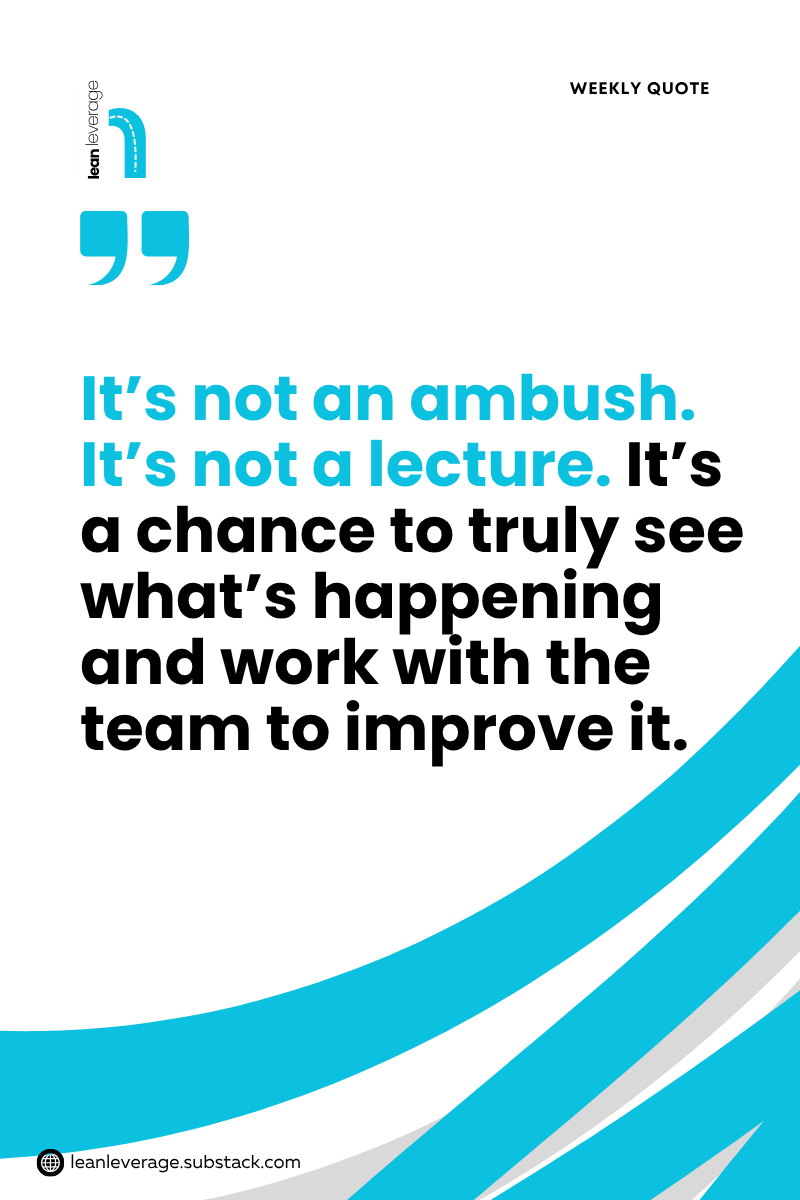How to Sabotage Your Gemba (Like a Pro)
Gemba is not for catching people slacking, unless you're also ready to catch the broken process behind it.
Hey friend,
I know this title is a bit cheeky, but stay with me.
A few years ago, when I was still an Operations Specialist SME (Subject Matter Expert), one of my weekly deliverables was to listen to painful customer calls. You know those types of calls so bad that you would instinctively reach for a sachet of Paracetamol before the second minute.
My job was simple:
Figure out what went wrong, how it happened, and what we could do better as a team to make sure it never happens again.
My manager called these “defect hunts”.
Why?
Because that’s exactly what they were. A hunt for defects in our software product, the service, and our processes.
In other words, identify the defects that lead to the poor customer experience, study them, and fix the root cause. More like what a quality assurance inspector with headphones would do.
Now, defect hunts are great. But they are not the same as a Gemba.
What is a Gemba Anyway?
I’ve seen all kinds of definitions for Gemba floating around. Some are cute, some are vague, some are even motivational.
"Gemba is the art of going and seeing."
"Gemba is leadership in motion."
But abeg!
If you popped the word “Gemba” into Google Translate (Japanese to English), it would return “on-site.” And that’s exactly what it is. Go to where the real work happens.
So when we say “Gemba Walk,” we mean go there; to the factory floor, to the ward, to the call centre, to the kitchen, not relying on what someone said in a meeting, or what a dashboard says from 2 months ago. Go to the place where value is being created for the customer.
All I’m saying here is that the definition of a Gemba is incomplete if it is missing “the place where the work is done”.
Do you understand?
A properly conducted Gemba allows you to:
Observe the actual process
Ask useful questions
Identify problems or improvement opportunities
Reduce waste
And build trust with the people closest to value creation
And while many amazing writers have taught you how to do a great Gemba, I thought I would take a different approach today.
Why?
Because sarcasm is a powerful tool for changing how we think.
African mums do this all the time.
Me: Mum, where should I place this bowl
Mum: (Angrily responds) Place it on my head!
You instantly start scanning the room for the right spot, because you're not ready to test destiny that day.
So permit me to push your thinking today like an African mum.
5 Steps to Sabotage Your Gemba
1. Hide the Goal of Your Visit
Don’t tell the staff you’ll be observing their process.
Just show up unannounced, like EFCC raiding a nightclub looking for yahoo boys.
No explanation. No context. Just appear like a spirit.
2. Judge Them Immediately
Once you arrive, don’t waste time. Start dishing out judgement.
Tell the staff everything they’re doing wrong.
Forget that you’ve never actually done the job before. You’ve read the SOP, so you’re clearly an expert!
3. Teach Instead of Observe
After all, you’re Mr/Ms ITK (I-too-know).
You don’t need to watch or listen; you already know everything.
So why observe when you can lecture them about a process you’ve never actually executed?
4. Don’t Ask Questions
You see them using a kitchen spoon to package cement instead of a different tool?
Don’t bother asking why.
Just assume they’re being difficult and write it down in your notes: “non-compliant with the official standards.”
There’s no need to ask questions and understand root causes. Who has that time?
5. Stand Them Up
This one is the ultimate move.
Book the Gemba. Tell them you’re coming.
Then… just don’t show up.
Or better still, show up 45 minutes late with a cup of coffee and blame “back-to-back meetings.”
Why observe real-life operations when there’s already a process map from 2020 in the shared drive?
Wrapping Up
Now pause. Reflect and think for a bit.
I hope you see the point.
What I’ve written is obviously sarcastic, but these things happen more often than we care to admit.
This list is not an exhaustive one, and there are many other ways to do a terrible Gemba.
Bruh, just don’t do any of them.
A good Gemba is built on curiosity, respect, and the willingness to learn.
It’s not an ambush. It’s not a lecture. It’s a chance to truly see what’s happening and work with the team to improve it.
If I’ve helped you reflect today, then my job here is done.
Till next time,
Tomiwa Femi-Philips
Improvement Enthusiast







Ohh I didn't knew this.. Gemba ...seems like I am bookmarking it...😊